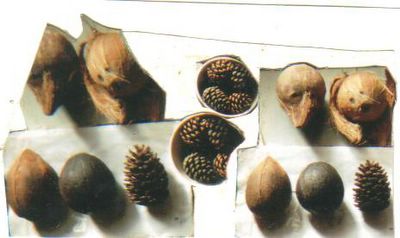
coconuts and pinecones

A second pair of photographs taken yesterday shows dried pinecones and coconuts at slightly different angles and illuminations. The bowl shows Pinus nigra cones dried-out after having sunk recently. The greater size of the now fully dry pinecone stranded at Chalkwell on April 7 2006 is illustrated by placing it beside them on the bottom left hand side of the four coconuts. Probably it is Pinus pinaster Aiton, with the apical scales fibrous and partly missing by the combined effects of maturation on the tree and beach erosion, prior to the final episode of marine transport from an unknown (English?) beach. Two of the coconuts also stranded in the Southend-on-Sea area, probably after being released into London canals for Hindu Rituals. The one on the top left stranded at Thorpe Bay during a S.W. gale at 16 hours. G.M.T. on January 13 2004, and shows a triangular mass of coir fibres truncated into a 10 mm diameter facet by Man rather than a natural erosive process in the Gulf Stream. It was then floated in the illustrated bucket, without drying during collection or major weight gains until it was removed on July 12 2006. During this time in the bucket the mass decreased from a maximum of about 806 g to about 673 g, and the orientation changed from coir-apex down to horizontal, presumably because the endosperm white flesh of the coconut gradually decayed. Certainly it now rattles about in this new even less dense dry state. One of the eyes was open enough for air bubbles to exit it when collected. An old water line in the bucket experiment can be hopefully seen on the photograph defined by a white band with a chord diameter of 80 mm on the opposite end of the nut from the coir fibres around the eyes. The overall length is 170 mm and the equatorial diameter 110 mm.
The stranded coconut on the top right is the one discussed on this blog and was found near Chalkwell Shelter on April 2 2006, with the husk separated and one of the eyes which had been covered by it seen to have a tunnel of white endosperm below it. In this case the husk looks more extensive than that seen usually on sale in England.; but might presumably have been imported for a Hindu niche market. I wish I knew exactly how Hindu’s prepare their coconuts for ritual refloatations and when. The usually cited and observed canal and coastal rituals are roughly in August and not when I see strandings at Southend. Natural drifting with the Gulf Stream is possible but would seem likely to produce more evidence of marine encrustation. Illustrations of stranded coconuts at intermediate sites would be instructive if they show what form the husk has after being floated by hurricanes etc.
The two lower coconuts were purchased from an English supermarket, where they are sold with less husk present than in some Green grocers shops. They are coconuts A (left) and B (right) of my notes in The Drifted Seed 2005 and 2006. The photograph is mainly of interest in showing that coconut B has become black during a second summer of drying after having sunk in seawater. The other coconut A shows the colouration after drying for just one summer and when any coconut has been in seawater for a day or so it is dark brown. In terms of mass changes in coconut B, there was an increase from about 550 g when purchases., to 620 g just after it sank and 644 g when drying started on day 626 of the experiment. Dehydration and perhaps some decay reduced the mass to 339 g on day 802; but after the nut became black again and leaked green copra oil from the eye the mass was further reduced to 259 g on day 1100 (which was just prior to the photography). Curiously when half-coconuts are left exposed to the air and not eaten by birds the flesh seems relatively stable at English temperatures.
No comments:
Post a Comment